Management Accounting Report: Principles and Applications
VerifiedAdded on 2020/10/22
|12
|3096
|460
Report
AI Summary
This report provides a comprehensive overview of management accounting principles and practices. It begins with defining management accounting, its role, and its differences from financial accounting. The report then delves into various management accounting systems, including cash budgets and inventory management systems, highlighting their benefits. It defines and explains the importance of budgeting, covering different types like static, zero-based, rolling, and incremental budgets, along with their advantages and disadvantages. The report also discusses inventory valuation methods, specifically LIFO and FIFO, outlining their definitions, advantages, and disadvantages. Furthermore, it presents break-even analysis and explores the role of management information systems in addressing financial challenges within an organization. The content aims to provide a solid understanding of management accounting concepts and their practical applications in business operations.
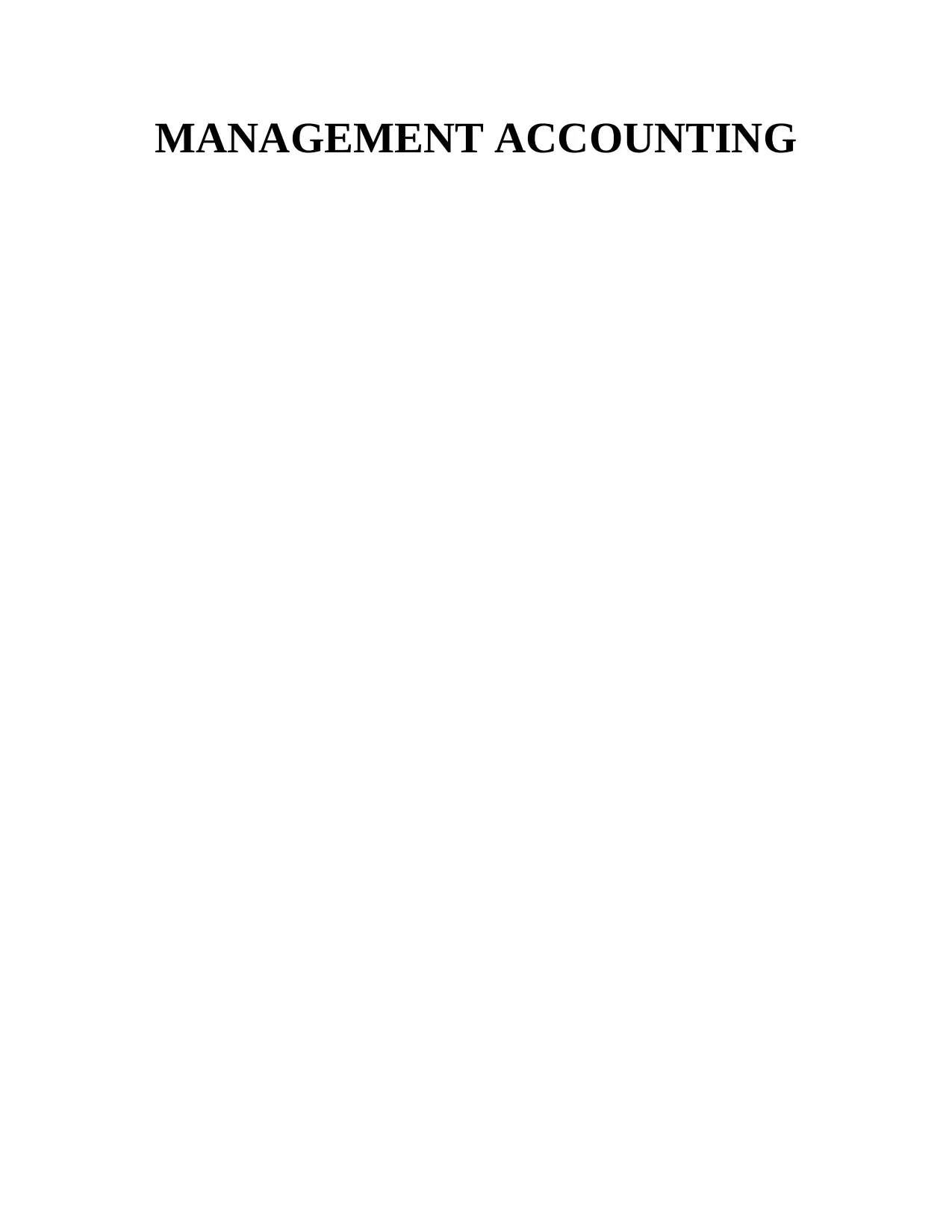
MANAGEMENT ACCOUNTING
Paraphrase This Document
Need a fresh take? Get an instant paraphrase of this document with our AI Paraphraser
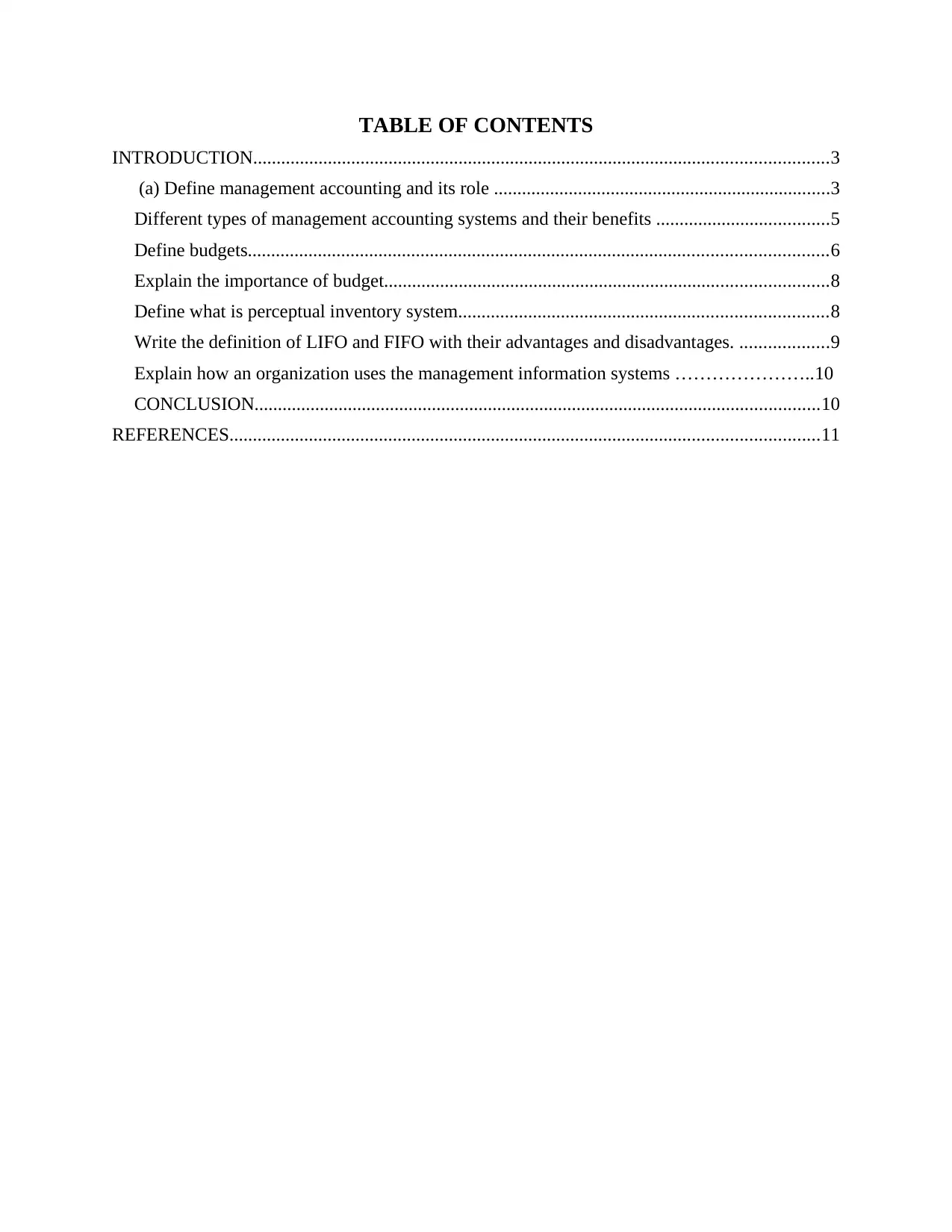
TABLE OF CONTENTS
INTRODUCTION...........................................................................................................................3
(a) Define management accounting and its role ........................................................................3
Different types of management accounting systems and their benefits .....................................5
Define budgets............................................................................................................................6
Explain the importance of budget...............................................................................................8
Define what is perceptual inventory system...............................................................................8
Write the definition of LIFO and FIFO with their advantages and disadvantages. ...................9
Explain how an organization uses the management information systems …………………..10
CONCLUSION.........................................................................................................................10
REFERENCES..............................................................................................................................11
INTRODUCTION...........................................................................................................................3
(a) Define management accounting and its role ........................................................................3
Different types of management accounting systems and their benefits .....................................5
Define budgets............................................................................................................................6
Explain the importance of budget...............................................................................................8
Define what is perceptual inventory system...............................................................................8
Write the definition of LIFO and FIFO with their advantages and disadvantages. ...................9
Explain how an organization uses the management information systems …………………..10
CONCLUSION.........................................................................................................................10
REFERENCES..............................................................................................................................11
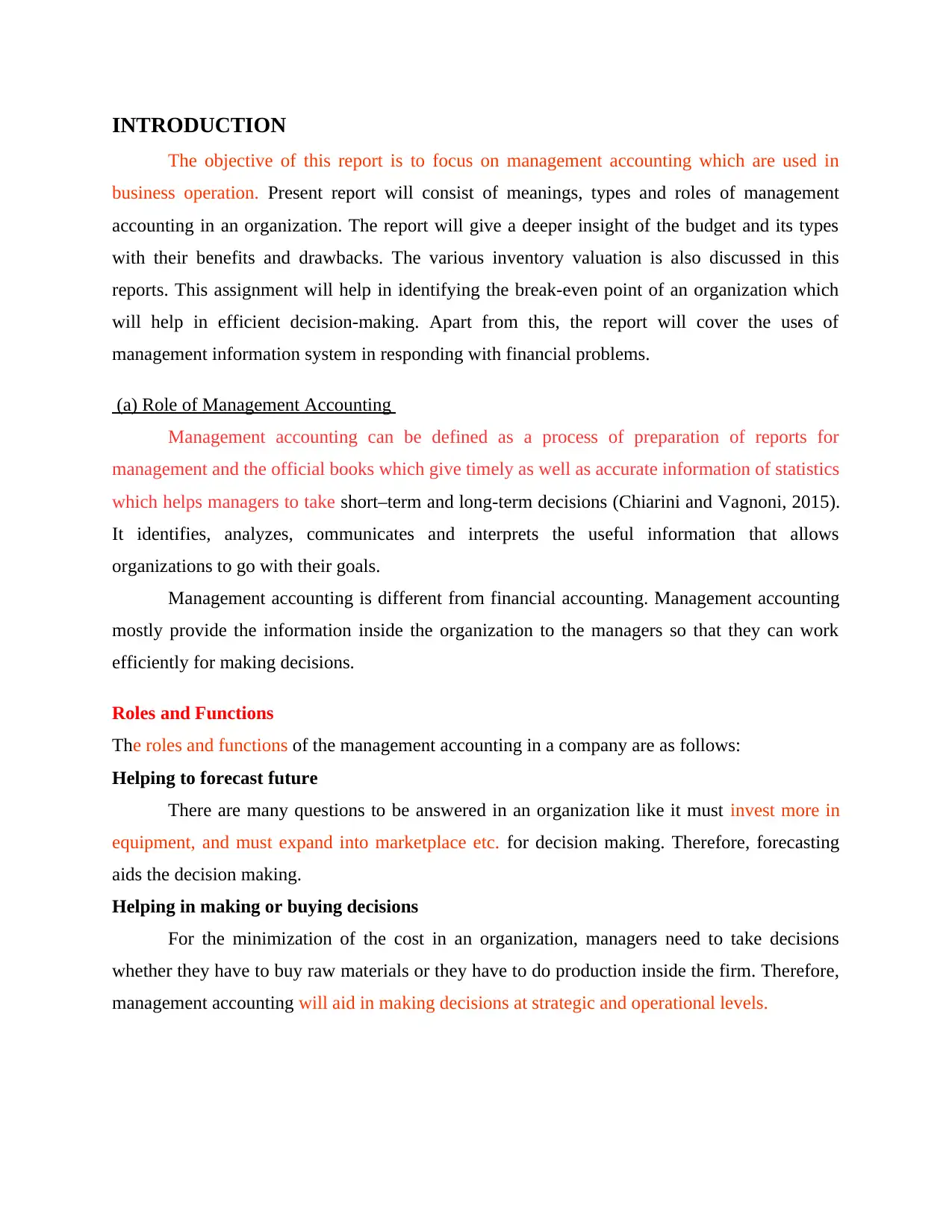
INTRODUCTION
The objective of this report is to focus on management accounting which are used in
business operation. Present report will consist of meanings, types and roles of management
accounting in an organization. The report will give a deeper insight of the budget and its types
with their benefits and drawbacks. The various inventory valuation is also discussed in this
reports. This assignment will help in identifying the break-even point of an organization which
will help in efficient decision-making. Apart from this, the report will cover the uses of
management information system in responding with financial problems.
(a) Role of Management Accounting
Management accounting can be defined as a process of preparation of reports for
management and the official books which give timely as well as accurate information of statistics
which helps managers to take short–term and long-term decisions (Chiarini and Vagnoni, 2015).
It identifies, analyzes, communicates and interprets the useful information that allows
organizations to go with their goals.
Management accounting is different from financial accounting. Management accounting
mostly provide the information inside the organization to the managers so that they can work
efficiently for making decisions.
Roles and Functions
The roles and functions of the management accounting in a company are as follows:
Helping to forecast future
There are many questions to be answered in an organization like it must invest more in
equipment, and must expand into marketplace etc. for decision making. Therefore, forecasting
aids the decision making.
Helping in making or buying decisions
For the minimization of the cost in an organization, managers need to take decisions
whether they have to buy raw materials or they have to do production inside the firm. Therefore,
management accounting will aid in making decisions at strategic and operational levels.
The objective of this report is to focus on management accounting which are used in
business operation. Present report will consist of meanings, types and roles of management
accounting in an organization. The report will give a deeper insight of the budget and its types
with their benefits and drawbacks. The various inventory valuation is also discussed in this
reports. This assignment will help in identifying the break-even point of an organization which
will help in efficient decision-making. Apart from this, the report will cover the uses of
management information system in responding with financial problems.
(a) Role of Management Accounting
Management accounting can be defined as a process of preparation of reports for
management and the official books which give timely as well as accurate information of statistics
which helps managers to take short–term and long-term decisions (Chiarini and Vagnoni, 2015).
It identifies, analyzes, communicates and interprets the useful information that allows
organizations to go with their goals.
Management accounting is different from financial accounting. Management accounting
mostly provide the information inside the organization to the managers so that they can work
efficiently for making decisions.
Roles and Functions
The roles and functions of the management accounting in a company are as follows:
Helping to forecast future
There are many questions to be answered in an organization like it must invest more in
equipment, and must expand into marketplace etc. for decision making. Therefore, forecasting
aids the decision making.
Helping in making or buying decisions
For the minimization of the cost in an organization, managers need to take decisions
whether they have to buy raw materials or they have to do production inside the firm. Therefore,
management accounting will aid in making decisions at strategic and operational levels.
⊘ This is a preview!⊘
Do you want full access?
Subscribe today to unlock all pages.

Trusted by 1+ million students worldwide
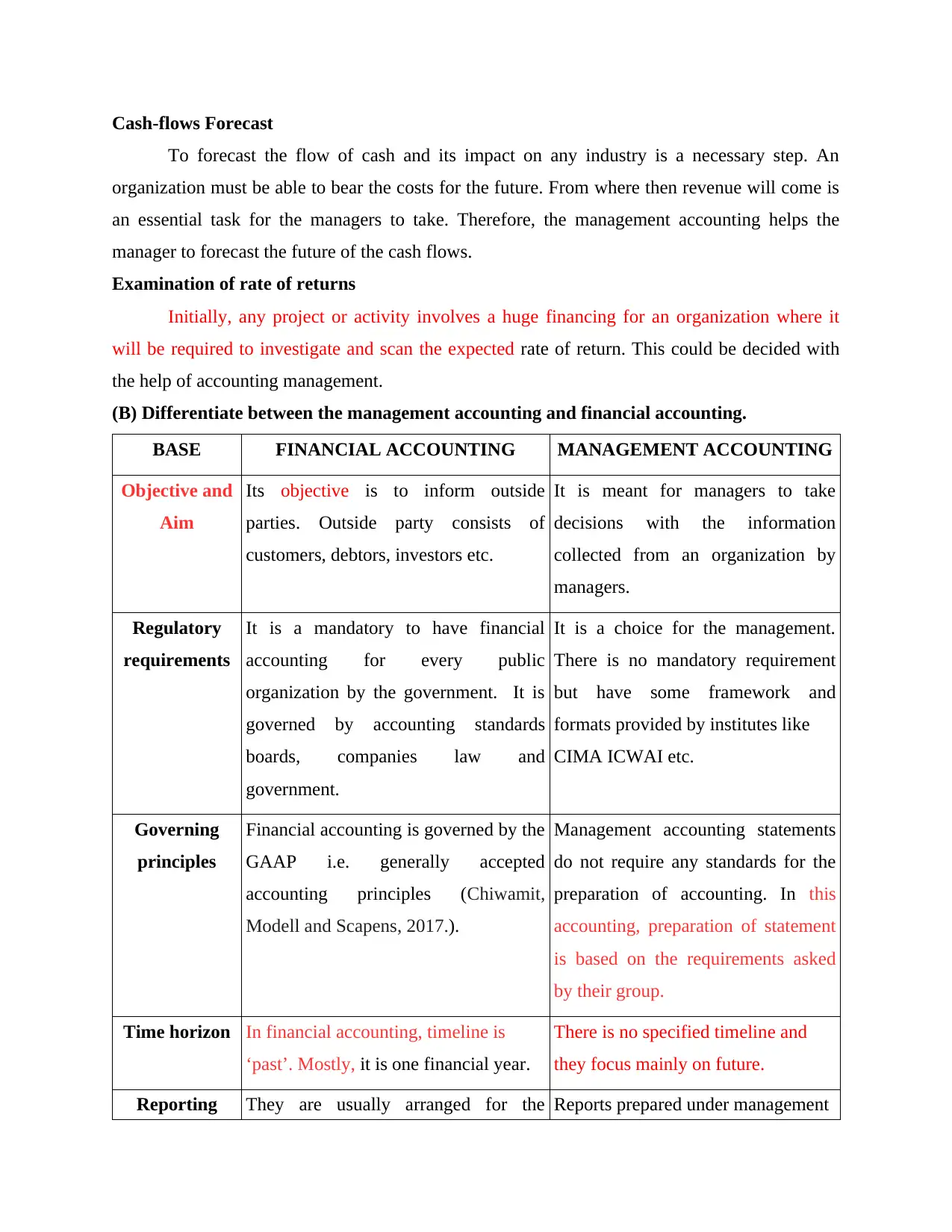
Cash-flows Forecast
To forecast the flow of cash and its impact on any industry is a necessary step. An
organization must be able to bear the costs for the future. From where then revenue will come is
an essential task for the managers to take. Therefore, the management accounting helps the
manager to forecast the future of the cash flows.
Examination of rate of returns
Initially, any project or activity involves a huge financing for an organization where it
will be required to investigate and scan the expected rate of return. This could be decided with
the help of accounting management.
(B) Differentiate between the management accounting and financial accounting.
BASE FINANCIAL ACCOUNTING MANAGEMENT ACCOUNTING
Objective and
Aim
Its objective is to inform outside
parties. Outside party consists of
customers, debtors, investors etc.
It is meant for managers to take
decisions with the information
collected from an organization by
managers.
Regulatory
requirements
It is a mandatory to have financial
accounting for every public
organization by the government. It is
governed by accounting standards
boards, companies law and
government.
It is a choice for the management.
There is no mandatory requirement
but have some framework and
formats provided by institutes like
CIMA ICWAI etc.
Governing
principles
Financial accounting is governed by the
GAAP i.e. generally accepted
accounting principles (Chiwamit,
Modell and Scapens, 2017.).
Management accounting statements
do not require any standards for the
preparation of accounting. In this
accounting, preparation of statement
is based on the requirements asked
by their group.
Time horizon In financial accounting, timeline is
‘past’. Mostly, it is one financial year.
There is no specified timeline and
they focus mainly on future.
Reporting They are usually arranged for the Reports prepared under management
To forecast the flow of cash and its impact on any industry is a necessary step. An
organization must be able to bear the costs for the future. From where then revenue will come is
an essential task for the managers to take. Therefore, the management accounting helps the
manager to forecast the future of the cash flows.
Examination of rate of returns
Initially, any project or activity involves a huge financing for an organization where it
will be required to investigate and scan the expected rate of return. This could be decided with
the help of accounting management.
(B) Differentiate between the management accounting and financial accounting.
BASE FINANCIAL ACCOUNTING MANAGEMENT ACCOUNTING
Objective and
Aim
Its objective is to inform outside
parties. Outside party consists of
customers, debtors, investors etc.
It is meant for managers to take
decisions with the information
collected from an organization by
managers.
Regulatory
requirements
It is a mandatory to have financial
accounting for every public
organization by the government. It is
governed by accounting standards
boards, companies law and
government.
It is a choice for the management.
There is no mandatory requirement
but have some framework and
formats provided by institutes like
CIMA ICWAI etc.
Governing
principles
Financial accounting is governed by the
GAAP i.e. generally accepted
accounting principles (Chiwamit,
Modell and Scapens, 2017.).
Management accounting statements
do not require any standards for the
preparation of accounting. In this
accounting, preparation of statement
is based on the requirements asked
by their group.
Time horizon In financial accounting, timeline is
‘past’. Mostly, it is one financial year.
There is no specified timeline and
they focus mainly on future.
Reporting They are usually arranged for the Reports prepared under management
Paraphrase This Document
Need a fresh take? Get an instant paraphrase of this document with our AI Paraphraser
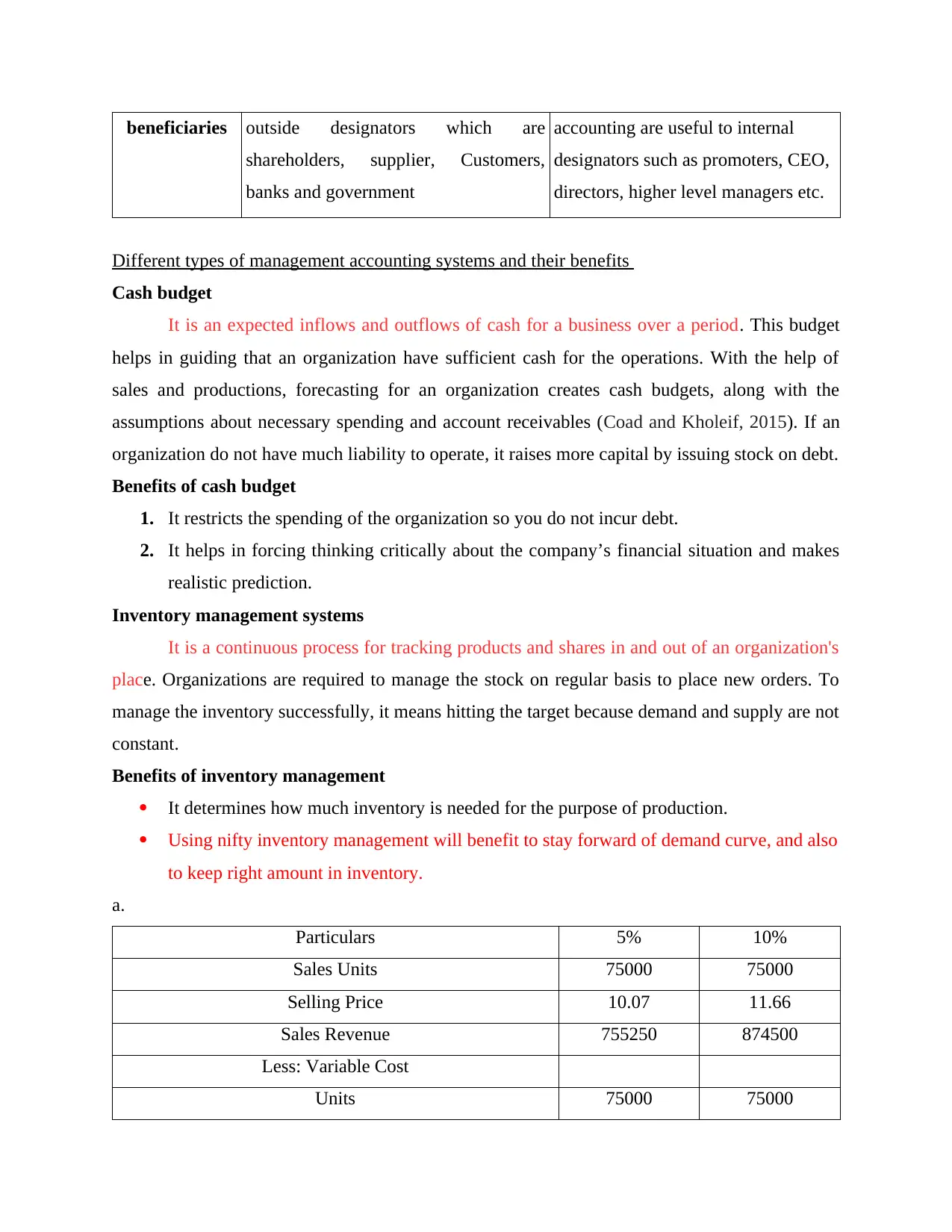
beneficiaries outside designators which are
shareholders, supplier, Customers,
banks and government
accounting are useful to internal
designators such as promoters, CEO,
directors, higher level managers etc.
Different types of management accounting systems and their benefits
Cash budget
It is an expected inflows and outflows of cash for a business over a period. This budget
helps in guiding that an organization have sufficient cash for the operations. With the help of
sales and productions, forecasting for an organization creates cash budgets, along with the
assumptions about necessary spending and account receivables (Coad and Kholeif, 2015). If an
organization do not have much liability to operate, it raises more capital by issuing stock on debt.
Benefits of cash budget
1. It restricts the spending of the organization so you do not incur debt.
2. It helps in forcing thinking critically about the company’s financial situation and makes
realistic prediction.
Inventory management systems
It is a continuous process for tracking products and shares in and out of an organization's
place. Organizations are required to manage the stock on regular basis to place new orders. To
manage the inventory successfully, it means hitting the target because demand and supply are not
constant.
Benefits of inventory management
It determines how much inventory is needed for the purpose of production.
Using nifty inventory management will benefit to stay forward of demand curve, and also
to keep right amount in inventory.
a.
Particulars 5% 10%
Sales Units 75000 75000
Selling Price 10.07 11.66
Sales Revenue 755250 874500
Less: Variable Cost
Units 75000 75000
shareholders, supplier, Customers,
banks and government
accounting are useful to internal
designators such as promoters, CEO,
directors, higher level managers etc.
Different types of management accounting systems and their benefits
Cash budget
It is an expected inflows and outflows of cash for a business over a period. This budget
helps in guiding that an organization have sufficient cash for the operations. With the help of
sales and productions, forecasting for an organization creates cash budgets, along with the
assumptions about necessary spending and account receivables (Coad and Kholeif, 2015). If an
organization do not have much liability to operate, it raises more capital by issuing stock on debt.
Benefits of cash budget
1. It restricts the spending of the organization so you do not incur debt.
2. It helps in forcing thinking critically about the company’s financial situation and makes
realistic prediction.
Inventory management systems
It is a continuous process for tracking products and shares in and out of an organization's
place. Organizations are required to manage the stock on regular basis to place new orders. To
manage the inventory successfully, it means hitting the target because demand and supply are not
constant.
Benefits of inventory management
It determines how much inventory is needed for the purpose of production.
Using nifty inventory management will benefit to stay forward of demand curve, and also
to keep right amount in inventory.
a.
Particulars 5% 10%
Sales Units 75000 75000
Selling Price 10.07 11.66
Sales Revenue 755250 874500
Less: Variable Cost
Units 75000 75000
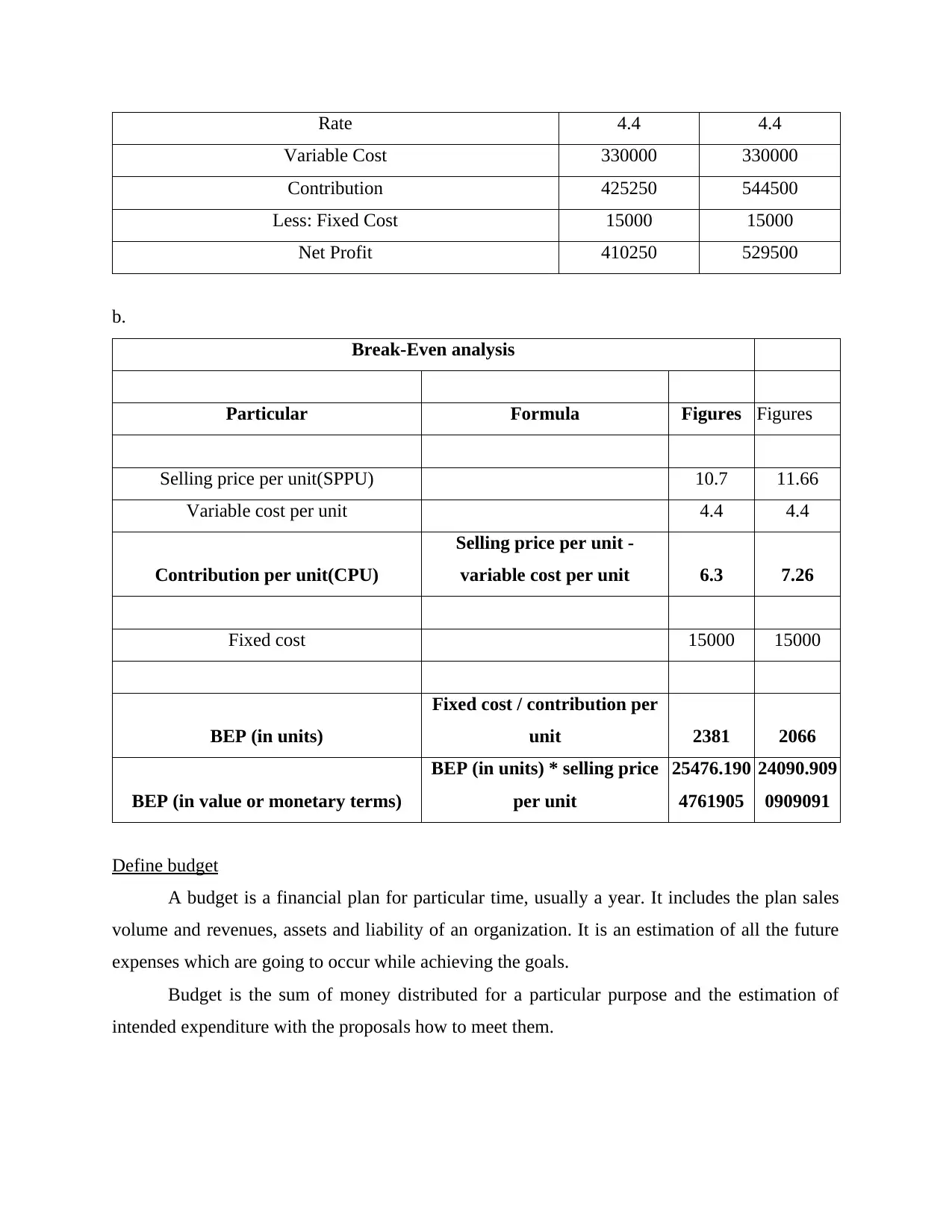
Rate 4.4 4.4
Variable Cost 330000 330000
Contribution 425250 544500
Less: Fixed Cost 15000 15000
Net Profit 410250 529500
b.
Break-Even analysis
Particular Formula Figures Figures
Selling price per unit(SPPU) 10.7 11.66
Variable cost per unit 4.4 4.4
Contribution per unit(CPU)
Selling price per unit -
variable cost per unit 6.3 7.26
Fixed cost 15000 15000
BEP (in units)
Fixed cost / contribution per
unit 2381 2066
BEP (in value or monetary terms)
BEP (in units) * selling price
per unit
25476.190
4761905
24090.909
0909091
Define budget
A budget is a financial plan for particular time, usually a year. It includes the plan sales
volume and revenues, assets and liability of an organization. It is an estimation of all the future
expenses which are going to occur while achieving the goals.
Budget is the sum of money distributed for a particular purpose and the estimation of
intended expenditure with the proposals how to meet them.
Variable Cost 330000 330000
Contribution 425250 544500
Less: Fixed Cost 15000 15000
Net Profit 410250 529500
b.
Break-Even analysis
Particular Formula Figures Figures
Selling price per unit(SPPU) 10.7 11.66
Variable cost per unit 4.4 4.4
Contribution per unit(CPU)
Selling price per unit -
variable cost per unit 6.3 7.26
Fixed cost 15000 15000
BEP (in units)
Fixed cost / contribution per
unit 2381 2066
BEP (in value or monetary terms)
BEP (in units) * selling price
per unit
25476.190
4761905
24090.909
0909091
Define budget
A budget is a financial plan for particular time, usually a year. It includes the plan sales
volume and revenues, assets and liability of an organization. It is an estimation of all the future
expenses which are going to occur while achieving the goals.
Budget is the sum of money distributed for a particular purpose and the estimation of
intended expenditure with the proposals how to meet them.
⊘ This is a preview!⊘
Do you want full access?
Subscribe today to unlock all pages.

Trusted by 1+ million students worldwide
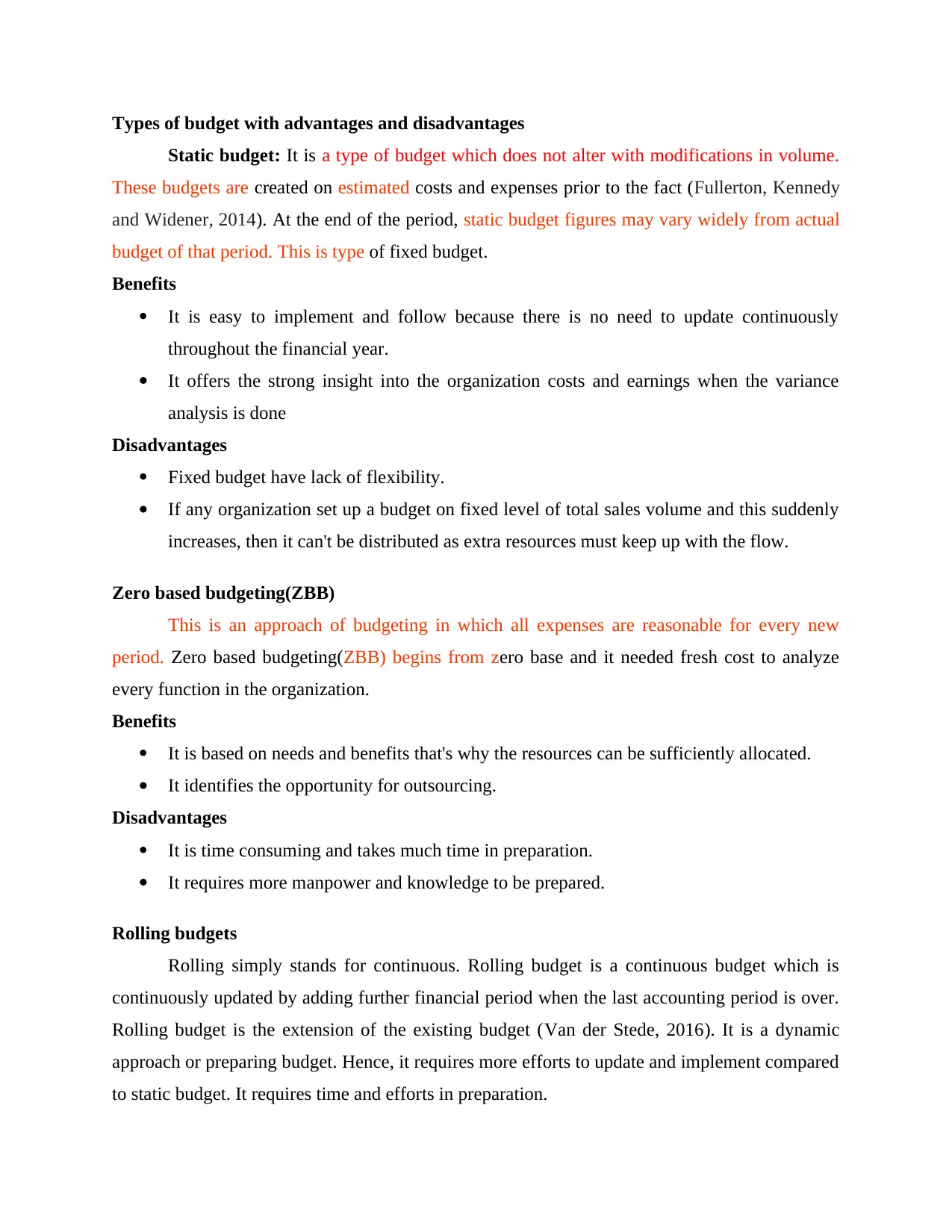
Types of budget with advantages and disadvantages
Static budget: It is a type of budget which does not alter with modifications in volume.
These budgets are created on estimated costs and expenses prior to the fact (Fullerton, Kennedy
and Widener, 2014). At the end of the period, static budget figures may vary widely from actual
budget of that period. This is type of fixed budget.
Benefits
It is easy to implement and follow because there is no need to update continuously
throughout the financial year.
It offers the strong insight into the organization costs and earnings when the variance
analysis is done
Disadvantages
Fixed budget have lack of flexibility.
If any organization set up a budget on fixed level of total sales volume and this suddenly
increases, then it can't be distributed as extra resources must keep up with the flow.
Zero based budgeting(ZBB)
This is an approach of budgeting in which all expenses are reasonable for every new
period. Zero based budgeting(ZBB) begins from zero base and it needed fresh cost to analyze
every function in the organization.
Benefits
It is based on needs and benefits that's why the resources can be sufficiently allocated.
It identifies the opportunity for outsourcing.
Disadvantages
It is time consuming and takes much time in preparation.
It requires more manpower and knowledge to be prepared.
Rolling budgets
Rolling simply stands for continuous. Rolling budget is a continuous budget which is
continuously updated by adding further financial period when the last accounting period is over.
Rolling budget is the extension of the existing budget (Van der Stede, 2016). It is a dynamic
approach or preparing budget. Hence, it requires more efforts to update and implement compared
to static budget. It requires time and efforts in preparation.
Static budget: It is a type of budget which does not alter with modifications in volume.
These budgets are created on estimated costs and expenses prior to the fact (Fullerton, Kennedy
and Widener, 2014). At the end of the period, static budget figures may vary widely from actual
budget of that period. This is type of fixed budget.
Benefits
It is easy to implement and follow because there is no need to update continuously
throughout the financial year.
It offers the strong insight into the organization costs and earnings when the variance
analysis is done
Disadvantages
Fixed budget have lack of flexibility.
If any organization set up a budget on fixed level of total sales volume and this suddenly
increases, then it can't be distributed as extra resources must keep up with the flow.
Zero based budgeting(ZBB)
This is an approach of budgeting in which all expenses are reasonable for every new
period. Zero based budgeting(ZBB) begins from zero base and it needed fresh cost to analyze
every function in the organization.
Benefits
It is based on needs and benefits that's why the resources can be sufficiently allocated.
It identifies the opportunity for outsourcing.
Disadvantages
It is time consuming and takes much time in preparation.
It requires more manpower and knowledge to be prepared.
Rolling budgets
Rolling simply stands for continuous. Rolling budget is a continuous budget which is
continuously updated by adding further financial period when the last accounting period is over.
Rolling budget is the extension of the existing budget (Van der Stede, 2016). It is a dynamic
approach or preparing budget. Hence, it requires more efforts to update and implement compared
to static budget. It requires time and efforts in preparation.
Paraphrase This Document
Need a fresh take? Get an instant paraphrase of this document with our AI Paraphraser
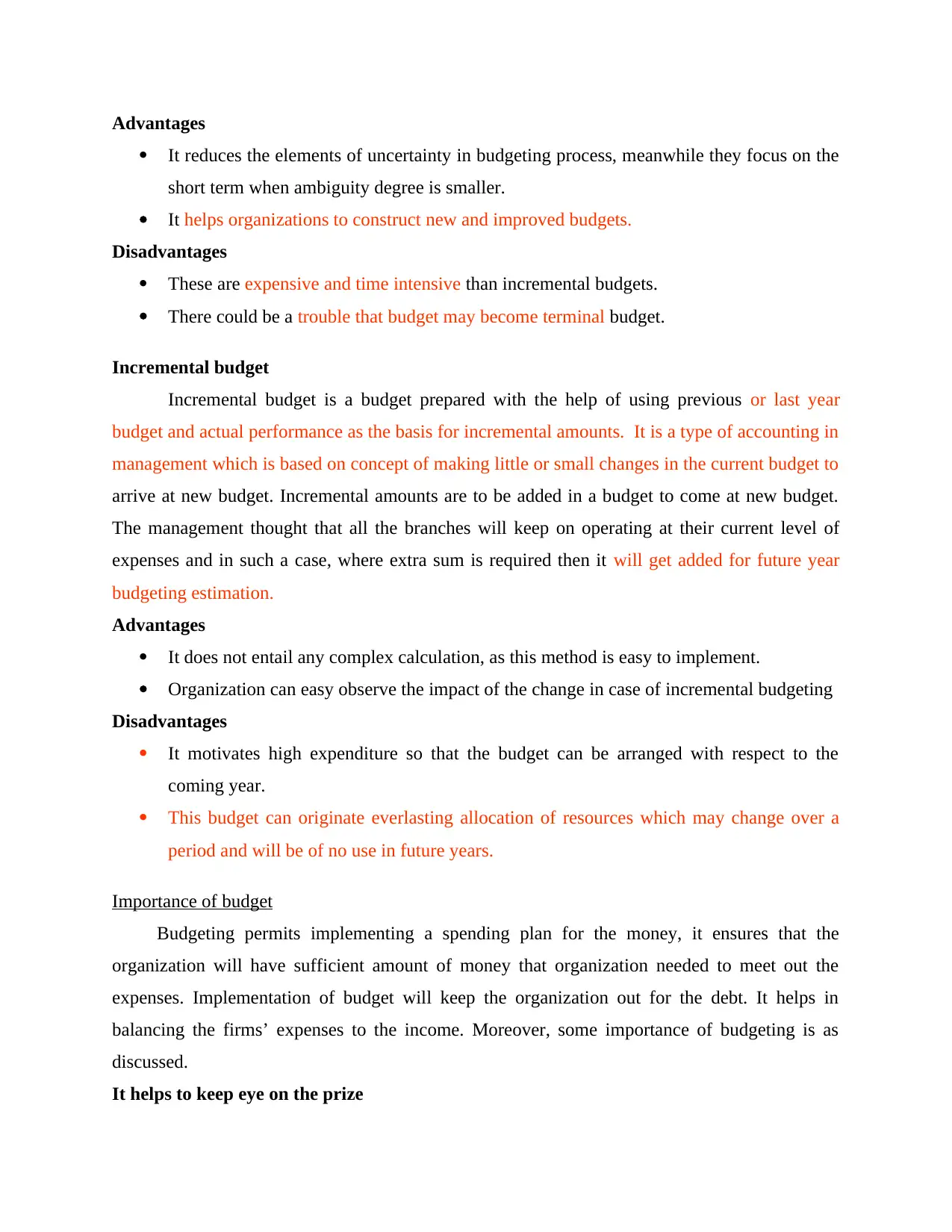
Advantages
It reduces the elements of uncertainty in budgeting process, meanwhile they focus on the
short term when ambiguity degree is smaller.
It helps organizations to construct new and improved budgets.
Disadvantages
These are expensive and time intensive than incremental budgets.
There could be a trouble that budget may become terminal budget.
Incremental budget
Incremental budget is a budget prepared with the help of using previous or last year
budget and actual performance as the basis for incremental amounts. It is a type of accounting in
management which is based on concept of making little or small changes in the current budget to
arrive at new budget. Incremental amounts are to be added in a budget to come at new budget.
The management thought that all the branches will keep on operating at their current level of
expenses and in such a case, where extra sum is required then it will get added for future year
budgeting estimation.
Advantages
It does not entail any complex calculation, as this method is easy to implement.
Organization can easy observe the impact of the change in case of incremental budgeting
Disadvantages
It motivates high expenditure so that the budget can be arranged with respect to the
coming year.
This budget can originate everlasting allocation of resources which may change over a
period and will be of no use in future years.
Importance of budget
Budgeting permits implementing a spending plan for the money, it ensures that the
organization will have sufficient amount of money that organization needed to meet out the
expenses. Implementation of budget will keep the organization out for the debt. It helps in
balancing the firms’ expenses to the income. Moreover, some importance of budgeting is as
discussed.
It helps to keep eye on the prize
It reduces the elements of uncertainty in budgeting process, meanwhile they focus on the
short term when ambiguity degree is smaller.
It helps organizations to construct new and improved budgets.
Disadvantages
These are expensive and time intensive than incremental budgets.
There could be a trouble that budget may become terminal budget.
Incremental budget
Incremental budget is a budget prepared with the help of using previous or last year
budget and actual performance as the basis for incremental amounts. It is a type of accounting in
management which is based on concept of making little or small changes in the current budget to
arrive at new budget. Incremental amounts are to be added in a budget to come at new budget.
The management thought that all the branches will keep on operating at their current level of
expenses and in such a case, where extra sum is required then it will get added for future year
budgeting estimation.
Advantages
It does not entail any complex calculation, as this method is easy to implement.
Organization can easy observe the impact of the change in case of incremental budgeting
Disadvantages
It motivates high expenditure so that the budget can be arranged with respect to the
coming year.
This budget can originate everlasting allocation of resources which may change over a
period and will be of no use in future years.
Importance of budget
Budgeting permits implementing a spending plan for the money, it ensures that the
organization will have sufficient amount of money that organization needed to meet out the
expenses. Implementation of budget will keep the organization out for the debt. It helps in
balancing the firms’ expenses to the income. Moreover, some importance of budgeting is as
discussed.
It helps to keep eye on the prize
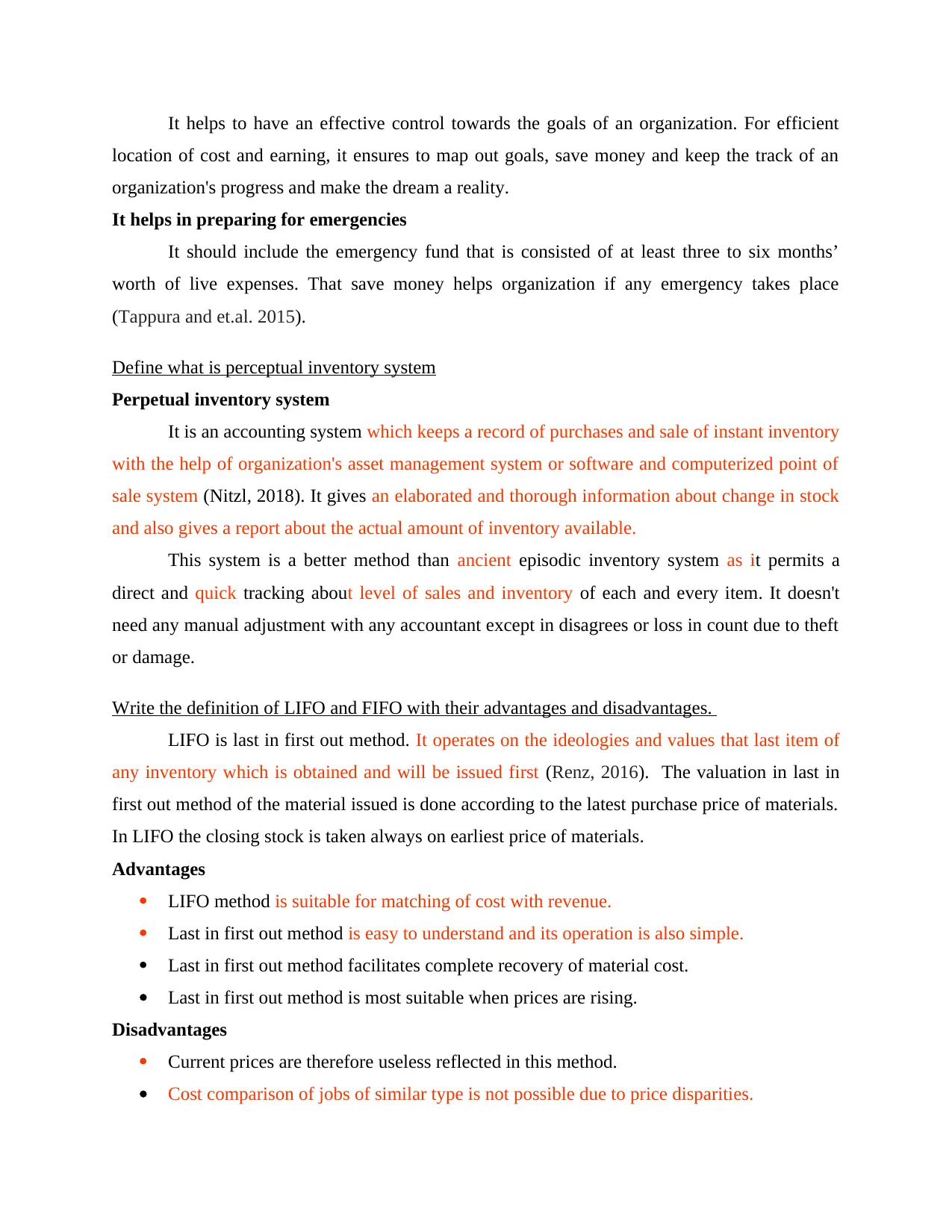
It helps to have an effective control towards the goals of an organization. For efficient
location of cost and earning, it ensures to map out goals, save money and keep the track of an
organization's progress and make the dream a reality.
It helps in preparing for emergencies
It should include the emergency fund that is consisted of at least three to six months’
worth of live expenses. That save money helps organization if any emergency takes place
(Tappura and et.al. 2015).
Define what is perceptual inventory system
Perpetual inventory system
It is an accounting system which keeps a record of purchases and sale of instant inventory
with the help of organization's asset management system or software and computerized point of
sale system (Nitzl, 2018). It gives an elaborated and thorough information about change in stock
and also gives a report about the actual amount of inventory available.
This system is a better method than ancient episodic inventory system as it permits a
direct and quick tracking about level of sales and inventory of each and every item. It doesn't
need any manual adjustment with any accountant except in disagrees or loss in count due to theft
or damage.
Write the definition of LIFO and FIFO with their advantages and disadvantages.
LIFO is last in first out method. It operates on the ideologies and values that last item of
any inventory which is obtained and will be issued first (Renz, 2016). The valuation in last in
first out method of the material issued is done according to the latest purchase price of materials.
In LIFO the closing stock is taken always on earliest price of materials.
Advantages
LIFO method is suitable for matching of cost with revenue.
Last in first out method is easy to understand and its operation is also simple.
Last in first out method facilitates complete recovery of material cost.
Last in first out method is most suitable when prices are rising.
Disadvantages
Current prices are therefore useless reflected in this method.
Cost comparison of jobs of similar type is not possible due to price disparities.
location of cost and earning, it ensures to map out goals, save money and keep the track of an
organization's progress and make the dream a reality.
It helps in preparing for emergencies
It should include the emergency fund that is consisted of at least three to six months’
worth of live expenses. That save money helps organization if any emergency takes place
(Tappura and et.al. 2015).
Define what is perceptual inventory system
Perpetual inventory system
It is an accounting system which keeps a record of purchases and sale of instant inventory
with the help of organization's asset management system or software and computerized point of
sale system (Nitzl, 2018). It gives an elaborated and thorough information about change in stock
and also gives a report about the actual amount of inventory available.
This system is a better method than ancient episodic inventory system as it permits a
direct and quick tracking about level of sales and inventory of each and every item. It doesn't
need any manual adjustment with any accountant except in disagrees or loss in count due to theft
or damage.
Write the definition of LIFO and FIFO with their advantages and disadvantages.
LIFO is last in first out method. It operates on the ideologies and values that last item of
any inventory which is obtained and will be issued first (Renz, 2016). The valuation in last in
first out method of the material issued is done according to the latest purchase price of materials.
In LIFO the closing stock is taken always on earliest price of materials.
Advantages
LIFO method is suitable for matching of cost with revenue.
Last in first out method is easy to understand and its operation is also simple.
Last in first out method facilitates complete recovery of material cost.
Last in first out method is most suitable when prices are rising.
Disadvantages
Current prices are therefore useless reflected in this method.
Cost comparison of jobs of similar type is not possible due to price disparities.
⊘ This is a preview!⊘
Do you want full access?
Subscribe today to unlock all pages.

Trusted by 1+ million students worldwide
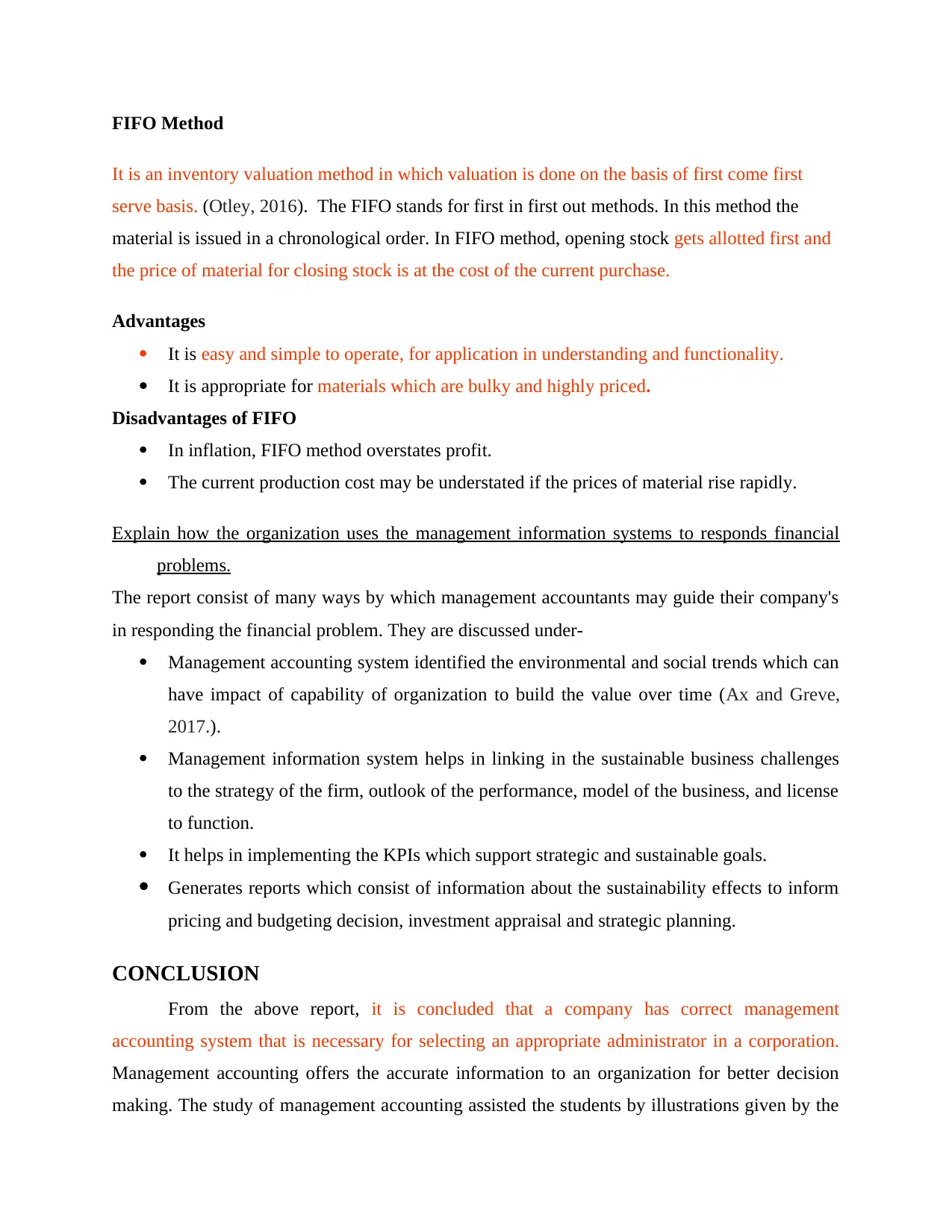
FIFO Method
It is an inventory valuation method in which valuation is done on the basis of first come first
serve basis. (Otley, 2016). The FIFO stands for first in first out methods. In this method the
material is issued in a chronological order. In FIFO method, opening stock gets allotted first and
the price of material for closing stock is at the cost of the current purchase.
Advantages
It is easy and simple to operate, for application in understanding and functionality.
It is appropriate for materials which are bulky and highly priced.
Disadvantages of FIFO
In inflation, FIFO method overstates profit.
The current production cost may be understated if the prices of material rise rapidly.
Explain how the organization uses the management information systems to responds financial
problems.
The report consist of many ways by which management accountants may guide their company's
in responding the financial problem. They are discussed under-
Management accounting system identified the environmental and social trends which can
have impact of capability of organization to build the value over time (Ax and Greve,
2017.).
Management information system helps in linking in the sustainable business challenges
to the strategy of the firm, outlook of the performance, model of the business, and license
to function.
It helps in implementing the KPIs which support strategic and sustainable goals.
Generates reports which consist of information about the sustainability effects to inform
pricing and budgeting decision, investment appraisal and strategic planning.
CONCLUSION
From the above report, it is concluded that a company has correct management
accounting system that is necessary for selecting an appropriate administrator in a corporation.
Management accounting offers the accurate information to an organization for better decision
making. The study of management accounting assisted the students by illustrations given by the
It is an inventory valuation method in which valuation is done on the basis of first come first
serve basis. (Otley, 2016). The FIFO stands for first in first out methods. In this method the
material is issued in a chronological order. In FIFO method, opening stock gets allotted first and
the price of material for closing stock is at the cost of the current purchase.
Advantages
It is easy and simple to operate, for application in understanding and functionality.
It is appropriate for materials which are bulky and highly priced.
Disadvantages of FIFO
In inflation, FIFO method overstates profit.
The current production cost may be understated if the prices of material rise rapidly.
Explain how the organization uses the management information systems to responds financial
problems.
The report consist of many ways by which management accountants may guide their company's
in responding the financial problem. They are discussed under-
Management accounting system identified the environmental and social trends which can
have impact of capability of organization to build the value over time (Ax and Greve,
2017.).
Management information system helps in linking in the sustainable business challenges
to the strategy of the firm, outlook of the performance, model of the business, and license
to function.
It helps in implementing the KPIs which support strategic and sustainable goals.
Generates reports which consist of information about the sustainability effects to inform
pricing and budgeting decision, investment appraisal and strategic planning.
CONCLUSION
From the above report, it is concluded that a company has correct management
accounting system that is necessary for selecting an appropriate administrator in a corporation.
Management accounting offers the accurate information to an organization for better decision
making. The study of management accounting assisted the students by illustrations given by the
Paraphrase This Document
Need a fresh take? Get an instant paraphrase of this document with our AI Paraphraser
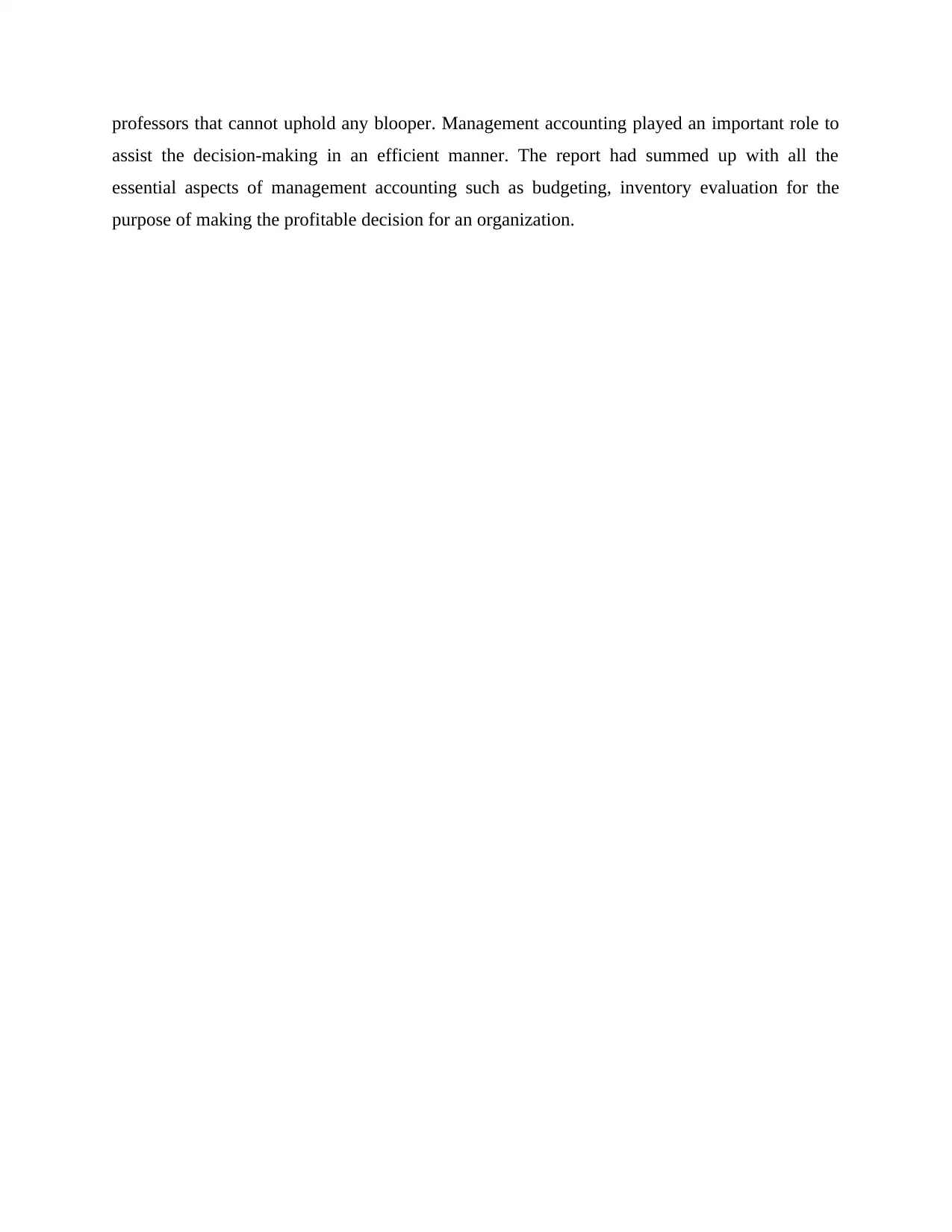
professors that cannot uphold any blooper. Management accounting played an important role to
assist the decision-making in an efficient manner. The report had summed up with all the
essential aspects of management accounting such as budgeting, inventory evaluation for the
purpose of making the profitable decision for an organization.
assist the decision-making in an efficient manner. The report had summed up with all the
essential aspects of management accounting such as budgeting, inventory evaluation for the
purpose of making the profitable decision for an organization.
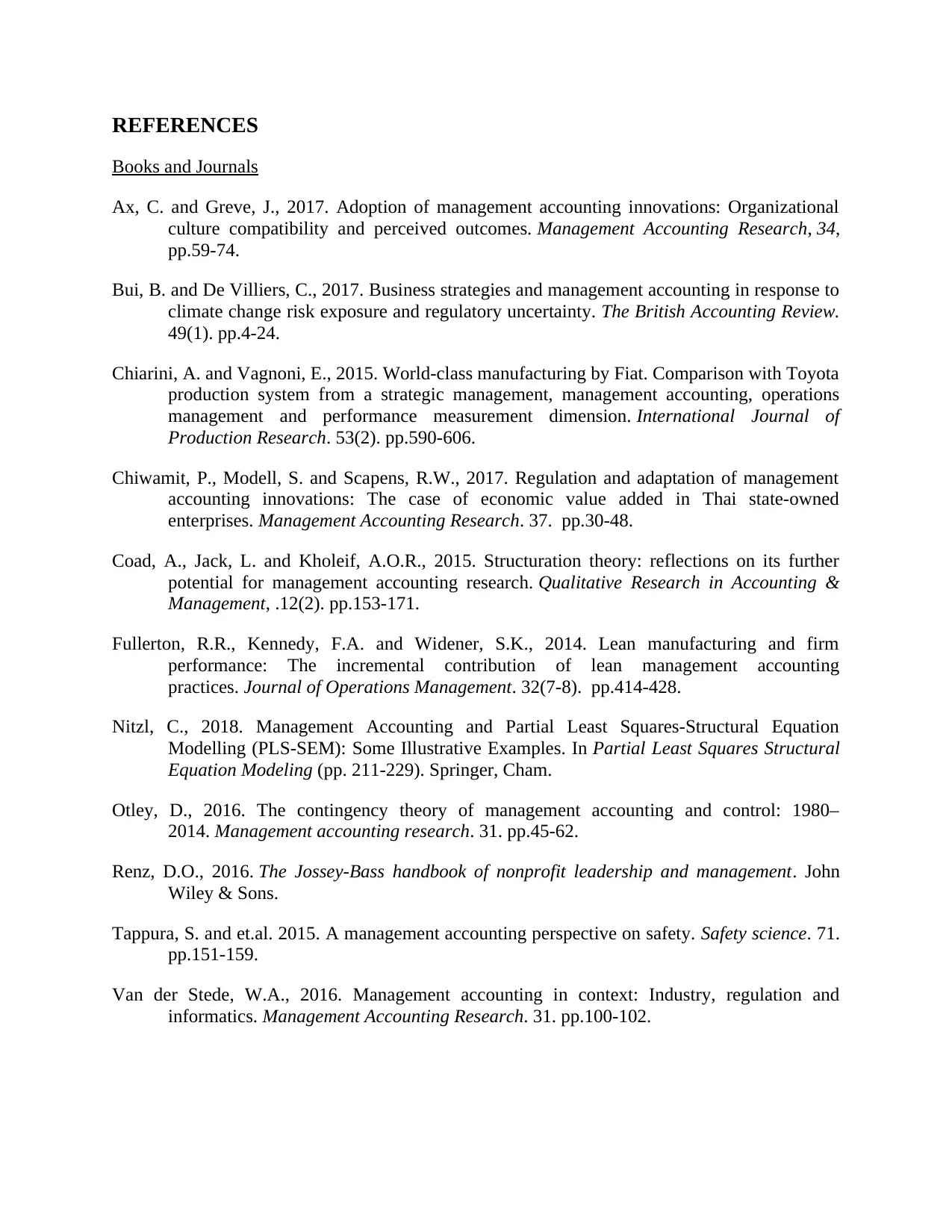
REFERENCES
Books and Journals
Ax, C. and Greve, J., 2017. Adoption of management accounting innovations: Organizational
culture compatibility and perceived outcomes. Management Accounting Research, 34,
pp.59-74.
Bui, B. and De Villiers, C., 2017. Business strategies and management accounting in response to
climate change risk exposure and regulatory uncertainty. The British Accounting Review.
49(1). pp.4-24.
Chiarini, A. and Vagnoni, E., 2015. World-class manufacturing by Fiat. Comparison with Toyota
production system from a strategic management, management accounting, operations
management and performance measurement dimension. International Journal of
Production Research. 53(2). pp.590-606.
Chiwamit, P., Modell, S. and Scapens, R.W., 2017. Regulation and adaptation of management
accounting innovations: The case of economic value added in Thai state-owned
enterprises. Management Accounting Research. 37. pp.30-48.
Coad, A., Jack, L. and Kholeif, A.O.R., 2015. Structuration theory: reflections on its further
potential for management accounting research. Qualitative Research in Accounting &
Management, .12(2). pp.153-171.
Fullerton, R.R., Kennedy, F.A. and Widener, S.K., 2014. Lean manufacturing and firm
performance: The incremental contribution of lean management accounting
practices. Journal of Operations Management. 32(7-8). pp.414-428.
Nitzl, C., 2018. Management Accounting and Partial Least Squares-Structural Equation
Modelling (PLS-SEM): Some Illustrative Examples. In Partial Least Squares Structural
Equation Modeling (pp. 211-229). Springer, Cham.
Otley, D., 2016. The contingency theory of management accounting and control: 1980–
2014. Management accounting research. 31. pp.45-62.
Renz, D.O., 2016. The Jossey-Bass handbook of nonprofit leadership and management. John
Wiley & Sons.
Tappura, S. and et.al. 2015. A management accounting perspective on safety. Safety science. 71.
pp.151-159.
Van der Stede, W.A., 2016. Management accounting in context: Industry, regulation and
informatics. Management Accounting Research. 31. pp.100-102.
Books and Journals
Ax, C. and Greve, J., 2017. Adoption of management accounting innovations: Organizational
culture compatibility and perceived outcomes. Management Accounting Research, 34,
pp.59-74.
Bui, B. and De Villiers, C., 2017. Business strategies and management accounting in response to
climate change risk exposure and regulatory uncertainty. The British Accounting Review.
49(1). pp.4-24.
Chiarini, A. and Vagnoni, E., 2015. World-class manufacturing by Fiat. Comparison with Toyota
production system from a strategic management, management accounting, operations
management and performance measurement dimension. International Journal of
Production Research. 53(2). pp.590-606.
Chiwamit, P., Modell, S. and Scapens, R.W., 2017. Regulation and adaptation of management
accounting innovations: The case of economic value added in Thai state-owned
enterprises. Management Accounting Research. 37. pp.30-48.
Coad, A., Jack, L. and Kholeif, A.O.R., 2015. Structuration theory: reflections on its further
potential for management accounting research. Qualitative Research in Accounting &
Management, .12(2). pp.153-171.
Fullerton, R.R., Kennedy, F.A. and Widener, S.K., 2014. Lean manufacturing and firm
performance: The incremental contribution of lean management accounting
practices. Journal of Operations Management. 32(7-8). pp.414-428.
Nitzl, C., 2018. Management Accounting and Partial Least Squares-Structural Equation
Modelling (PLS-SEM): Some Illustrative Examples. In Partial Least Squares Structural
Equation Modeling (pp. 211-229). Springer, Cham.
Otley, D., 2016. The contingency theory of management accounting and control: 1980–
2014. Management accounting research. 31. pp.45-62.
Renz, D.O., 2016. The Jossey-Bass handbook of nonprofit leadership and management. John
Wiley & Sons.
Tappura, S. and et.al. 2015. A management accounting perspective on safety. Safety science. 71.
pp.151-159.
Van der Stede, W.A., 2016. Management accounting in context: Industry, regulation and
informatics. Management Accounting Research. 31. pp.100-102.
⊘ This is a preview!⊘
Do you want full access?
Subscribe today to unlock all pages.

Trusted by 1+ million students worldwide
1 out of 12
Related Documents
Your All-in-One AI-Powered Toolkit for Academic Success.
+13062052269
info@desklib.com
Available 24*7 on WhatsApp / Email
![[object Object]](/_next/static/media/star-bottom.7253800d.svg)
Unlock your academic potential
Copyright © 2020–2025 A2Z Services. All Rights Reserved. Developed and managed by ZUCOL.





